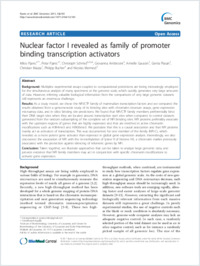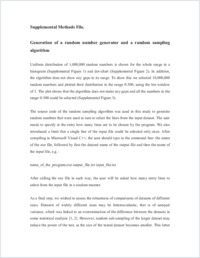Nuclear factor I revealed as family of promoter binding transcription activators
- Pjanic, Milos Institute of Biotechnology, University of Lausanne, and Center for Biotechnology of the University of Lausanne and École Polytechnique Fédérale de Lausanne, Switzerland
- Pjanic, Petar Software Examination and Certification Laboratory, Faculty of Mathematics, University of Belgrade, Serbia
- Schmid, Christoph Swiss Institute for Experimental Cancer Research, École Polytechnique Fédérale de Lausanne, Switzerland - Swiss Tropical and Public Health Institute, Basel, Switzerland - Universität Basel, Switzerland - Swiss Institute of Bioinformatics, EPFL SV ISREC, Lausanne, Switzerland
- Ambrosini, Giovanna Swiss Institute for Experimental Cancer Research, École Polytechnique Fédérale de Lausanne, Switzerland
- Gaussin, Armelle Institute of Biotechnology, University of Lausanne, and Center for Biotechnology of the University of Lausanne and École Polytechnique Fédérale de Lausanne, Switzerland
- Plasari, Genta Institute of Biotechnology, University of Lausanne, and Center for Biotechnology of the University of Lausanne and École Polytechnique Fédérale de Lausanne, Switzerland
- Mazza, Christian Department of Mathematics, University of Fribourg, Switzerland
- Bucher, Philipp Swiss Institute for Experimental Cancer Research, École Polytechnique Fédérale de Lausanne, Switzerland
- Mermod, Nicolas Institute of Biotechnology, University of Lausanne, and Center for Biotechnology of the University of Lausanne and École Polytechnique Fédérale de Lausanne, Switzerland
-
07.04.2011
Published in:
- BMC Genomics. - 2011, vol. 12, p. 181
English
Background: Multiplex experimental assays coupled to computational predictions are being increasingly employed for the simultaneous analysis of many specimens at the genome scale, which quickly generates very large amounts of data. However, inferring valuable biological information from the comparisons of very large genomic datasets still represents an enormous challenge.Results: As a study model, we chose the NFI/CTF family of mammalian transcription factors and we compared the results obtained from a genome-wide study of its binding sites with chromatin structure assays, gene expression microarray data, and in silico binding site predictions. We found that NFI/CTF family members preferentially bind their DNA target sites when they are located around transcription start sites when compared to control datasets generated from the random subsampling of the complete set of NFI binding sites. NFI proteins preferably associate with the upstream regions of genes that are highly expressed and that are enriched in active chromatin modifications such as H3K4me3 and H3K36me3. We postulate that this is a causal association and that NFI proteins mainly act as activators of transcription. This was documented for one member of the family (NFI-C), which revealed as a more potent gene activator than repressor in global gene expression analysis. Interestingly, we also discovered the association of NFI with the tri-methylation of lysine 9 of histone H3, a chromatin marker previously associated with the protection against silencing of telomeric genes by NFI.Conclusion Taken together, we illustrate approaches that can be taken to analyze large genomic data, and provide evidence that NFI family members may act in conjunction with specific chromatin modifications to activate gene expression.
- Faculty
- Faculté des sciences et de médecine
- Department
- Département de Mathématiques
- Language
-
- English
- Classification
- Biological sciences
- License
-
License undefined
- Identifiers
-
- RERO DOC 22788
- DOI 10.1186/1471-2164-12-181
- Persistent URL
- https://folia.unifr.ch/unifr/documents/301857
Other files
Statistics
Document views: 123
File downloads:
- pdf: 149
- Supplementary material (code): 152
- Supplementary material: 120


